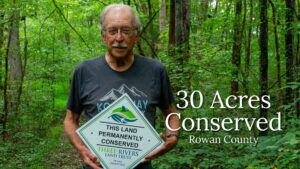
by Crystal Cockman
January 26, 2017
 PBS aired a documentary recently on renowned conservationist Rachel Carson. Best known for writing Silent Spring, a book that brought to light the negative human and environmental effects of synthetic pesticides, Carson was instrumental in advancing the modern environmental movement.
PBS aired a documentary recently on renowned conservationist Rachel Carson. Best known for writing Silent Spring, a book that brought to light the negative human and environmental effects of synthetic pesticides, Carson was instrumental in advancing the modern environmental movement.
Carson was raised on a 65-acre farm in Springdale, Pennsylvania. She began writing at a young age, having her first published story at the age of ten. She attended the Pennsylvania College for Women (now Chatham University), starting as an English major and then switching to Biology. She continued her studies at Johns Hopkins University and earned a masters degree in Zoology in 1932. Her father soon passed away, leaving her to care for her aging mother, so she had to leave her studies to raise money for her family.
She took a part-time job with the U.S. Bureau of Fisheries writing stories for a series of radio broadcasts about aquatic life. She was such a success at this that her supervisor worked to help her obtain a permanent job, and in 1936 she became only the second woman hired for a full-time position with the Bureau of Fisheries as a junior aquatic biologist.
Carson published an essay called Undersea in the Atlantic Monthly, which brought her to the attention of publishers Simon and Schuster, who encouraged her to expand it into a book. This resulted in Under the Sea Wind, a book that had good reviews but did not initially sell well.
In 1937, her sister also died, and Carson was the only source of income for her mother and two nieces. The Bureau of Fisheries became the U.S. Fish and Wildlife Service, and Carson rose within the ranks to chief editor of publications in 1949. She began transitioning to a full-time writer, and Oxford University Press published her next book, The Sea Around Us, in 1951. This book was a huge success, earning her multiple accolades and was on the New York Times Bestseller List for 86 weeks. Her next book, Under the Sea Wind, was also a bestseller. She gave up her job in 1952 to write full-time, and she moved to Maine. In 1953, she completed the third book on the sea, The Edge of the Sea.
In 1957, one of her nieces passed away leaving a son, Roger Christie, which Rachel adopted, and she moved to Maryland. Soon thereafter began her interest in the ecological effects of the widespread use of pesticides. Silent Spring was published in 1962. The title of the book alludes to the disappearance of birds and thus their songs as a result of the overuse of synthetic pesticides. She had gathered information from numerous scientists about the deleterious effects of pesticides, in particular DDT. The book focuses on the detrimental effects synthetic pesticides have on both the natural environment and human health. Her overall point was not even that pesticides be banned, but used in sparing amounts, as little as needed instead of the rampant overuse that was then currently occurring. Rachel herself developed cancer while writing the book.
There was much pushback from the chemical industry, with some threats of suing her for libel. The academic community and eventually public opinion as well supported Carson’s claims. CBS Reports did a television special on her book in 1963, with an estimated audience of 10-15 million people. The television show resulted in a congressional review of pesticide dangers and a pesticide report by the President’s Science Advisory Committee. The opposition to the book was largely quelled.
Carson was invited to many speaking engagements, but her failing health prevented her from attending many. She did testify before President John F. Kennedy’s Science Advisory Committee, and before a U.S. Senate subcommittee to make policy recommendations. She also appeared on The Today Show. Rachel passed away on April 14, 1964.
Silent Spring was the first book to call for a reconsideration of the use of pesticides for the sake of progress, or the control of nature by human-created chemicals. The modern environmental movement is believed to have started with this book. Agencies like the Environmental Defense Fund and even the Environmental Protection Agency were brought about to address many of the concerns Carson laid out in her book. DDT was eventually banned. We owe a debt of gratitude to Rachel Carson for her brave work, which has resulted in the protection of our natural environment and a safer place for us all to live.